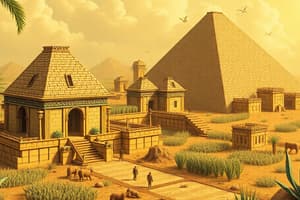Podcast
Questions and Answers
What was the impact of the discovery of the Cape of Good Hope on the Egyptian economy during the Ottoman rule?
What was the impact of the discovery of the Cape of Good Hope on the Egyptian economy during the Ottoman rule?
The discovery of the Cape of Good Hope led to a decline in the Egyptian economy.
What was the primary sector that the Egyptian economy relied on during the Ottoman rule?
What was the primary sector that the Egyptian economy relied on during the Ottoman rule?
Agriculture
What was the result of the integration of the Ottoman economy into world markets and trade with industrial Europe?
What was the result of the integration of the Ottoman economy into world markets and trade with industrial Europe?
The Ottoman economy transformed into an exporter of primary products and importer of manufactures.
What was the role of the Sultan in the Ottoman political system?
What was the role of the Sultan in the Ottoman political system?
What was the 'milk al-manfa'a' or 'usufruct right' in the context of land ownership in Ottoman Egypt?
What was the 'milk al-manfa'a' or 'usufruct right' in the context of land ownership in Ottoman Egypt?
What was the impact of wars and political struggles on the economy during the Ottoman rule in Egypt?
What was the impact of wars and political struggles on the economy during the Ottoman rule in Egypt?
What was the significance of the French occupation of Egypt in the context of the Ottoman economy?
What was the significance of the French occupation of Egypt in the context of the Ottoman economy?
What was the role of the Pashas and Beys in the Ottoman political system?
What was the role of the Pashas and Beys in the Ottoman political system?
What was the impact of the Ottoman economy's integration into world markets on the economy?
What was the impact of the Ottoman economy's integration into world markets on the economy?
How did the economic system of Ottoman Egypt reflect Islamic economic principles?
How did the economic system of Ottoman Egypt reflect Islamic economic principles?
Flashcards are hidden until you start studying
Study Notes
Farmers' Rights and Taxation
- Farmers had limited rights to use the land under the "Right Of Obligation" rule, which included paying taxes and providing a portion of the harvest as rent.
- The taxation system placed a heavy financial burden on farmers, with unfair and cruel tax collection methods.
Modernization Efforts
- New technology, better crop management, infrastructure improvement, and water efficiency were introduced to modernize the agricultural sector.
Crafts and Industry
- Crafts were considered the national industry in Egypt, reflecting the country's cultural identity.
- During the Ottoman rule, crafts and industry went through three stages:
- Revival stage (16th-18th): Traditional crafts flourished, attracting skilled artisans to cities, resulting in high-quality goods.
- Challenges stage (19th): External pressures and political instability led to a decline in crafts and some industries.
- Modernization stage (19th-20th): Introduced better production methods, infrastructure, and new industries, as well as improved transportation networks like the Suez Canal.
Trade and Commerce
- The Ottoman Empire focused on trade to boost its welfare, extending from the Mediterranean Sea to the Crimean Peninsula.
- Internal trade was mainly agricultural products, with some textile manufacturing.
- Egypt played a central role in trade, and its monetary policies aligned with the Ottoman Empire's overall economic strategy.
Monetary Policy Analysis
- Advantages:
- Standardized Policy: allowed for a stabilized economic framework
- Economic Integration: A common currency facilitated trade between different regions of the Ottoman Empire
- Disadvantages:
- Silver Price Fluctuations: The value of silver fluctuated on the global market, disrupting trade and making international transactions unpredictable
- Debasement Temptation: Short-term financial gain led to inflation, erosion of purchasing power, and loss of confidence in the currency
Agriculture and Land Occupancy
- Land occupancy in Egypt was influenced by Islamic principles, with landowners paying a fixed amount to the state's treasury.
- Lands were divided into individual and state ownership, with tax-farmers (collectors) and lord's ownership based on their position in administrative and military sectors.
- Types of lands that existed during the Ottoman rule:
- State-owned (Miri)
- Privately owned (Mulk)
- Leased lands (iltizam)
- Elite-owned (khassa)
Historical Context
- Ottoman reign in Egypt began in 1517 after Sultan Selim I defeated the Mamluks.
- Economic decline continued under Ottoman rule, especially after the discovery of the Cape of Good Hope.
- Three key aspects to address when reviewing the historical context:
- Agriculture: Land ownership belonged to the sultan, and farmers worked the land after paying taxes.
- Industry: Limited industrialization efforts in Egypt before modernization, with the economy relying primarily on the agricultural sector.
- Commerce: Wars and political struggles disrupted long-distance trade, agriculture, and manufacturing, leading to inflation and integration into world markets.
The Political System
- The Ottoman Empire was a powerful empire that existed from 1299 to 1924, with the Sultan having ultimate authority and power to appoint or dismiss officials.
- The Grand Visir was the chief minister, while the Pashas and Beys were governors of the Empire's provinces, responsible for collecting taxes, maintaining local military forces, and acting as judges.
Studying That Suits You
Use AI to generate personalized quizzes and flashcards to suit your learning preferences.




